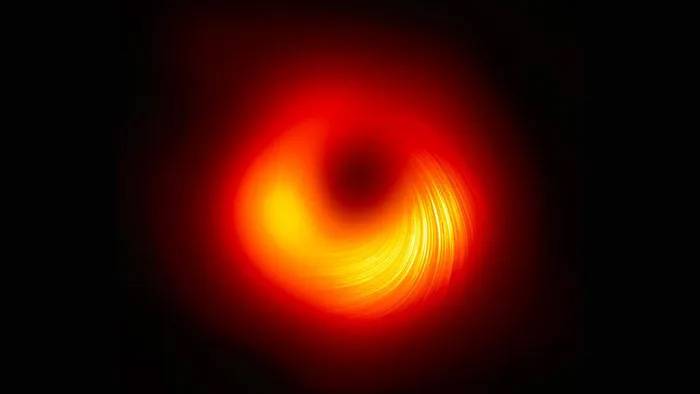The search for a hypothetical subatomic particle (a building block of atoms) is expected to provide fresh insights that could narrow the path of research in physics—thanks to the swirling light around a massive black hole in another galaxy.
The lightweight particle—known as the axion—has been proposed as a solution to the mystery of why the universe has so little antimatter and is a candidate for the elusive dark matter that fills the cosmos. The swirling and chaotic regions surrounding the central black hole of the M87 galaxy are also believed to encode information about such particles.
According to a report published in Nature Astronomy on March 17, researchers detailed how the orientation of light around the M87 black hole could rule out the possibility of axion particles appearing within a specific mass range.

Lines indicate the polarization or orientation of light waves emitted from the region surrounding the supermassive black hole in the M87 galaxy.
This study also demonstrates that scientists can use a similar method in upcoming astronomical observations to search for these particles with varying masses.
Physicist Benjamin Safdi from the University of California, Berkeley shared: “This is a really interesting idea. They have proposed a new method and shown that this method could, in principle, work.”
First proposed in the late 1970s, axions have yet to be detected in experiments. The theoretical work since that initial proposal has indicated that there could be a family of axions, each with different masses but all interacting weakly with ordinary matter. In 2020, physicist Yifan Chen from the Chinese Academy of Sciences in Beijing and colleagues described a method for searching for axions by using observations of light around black holes.
Theoretically, a rapidly spinning black hole could create a dense cloud of axion particles in the surrounding area almost immediately. The exact type of axion formed depends on the width of the black hole. The supermassive black hole in M87 is large enough to potentially cook up a stew of ultra-light particles resembling axions. If this black hole indeed generates such a cloud, it would alter the direction, or polarization, of the light coming from that region. Notably, the polarization would fluctuate over time.
Unfortunately, no one had any images of polarized light from a black hole to test this—until last year. That was when the Event Horizon Telescope, or EHT, a network of radio telescopes spanning the globe, revealed images of polarized light around the supermassive black hole at the center of M87 (SN: 3/24/21).
Particle physicist Yue Zhao from the University of Utah in Salt Lake City stated: “This is precisely the information we need to carry out this theoretical proposal. We have a very extreme condition that could produce a large number of axions, and we have the right tools to study the signatures of these axions.”
Thus, Zhao, Chen, and their colleagues examined EHT data for temporal changes in the direction of polarization. While an axion cloud would change direction, so would the active and chaotic region around the black hole. Zhao noted: “This is a kind of unavoidable background we have to deal with. After subtracting that signal from the total signal, they found that there wasn’t enough additional fluctuation to say that any signal could come from an axion cloud.” They ruled out the existence of ultra-light axions with masses around 10 billionths of a billionth of an electron’s mass.
However, a similar technique could also be used to hunt for other axion-like particles. Zhao added: <em“Having a larger black hole means your axion mass could be lighter. Physicists hope to use future EHT observations of other black holes to search for axions with different masses. Zhao noted that one black hole on the EHT radar is the monstrous one at the center of our galaxy, with a mass one-thousandth that of M87 (SN: 6/5/19). If our galaxy's monster black hole has an axion cloud, it would be heavier particles.”
Safdi remarked: “The idea of searching for these axion-like particles, in my opinion, is the most exciting thing happening in particle physics right now.”


















































